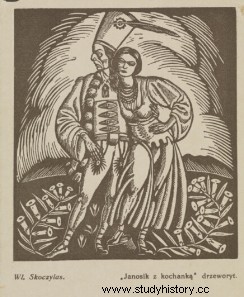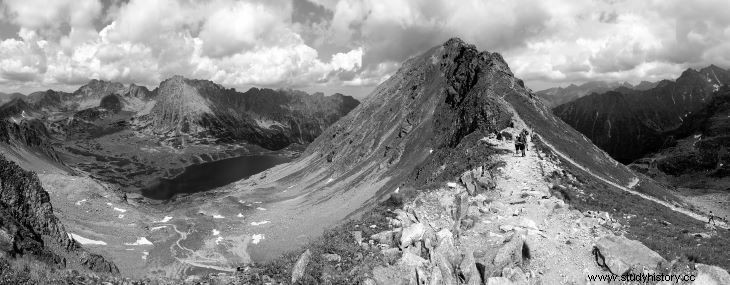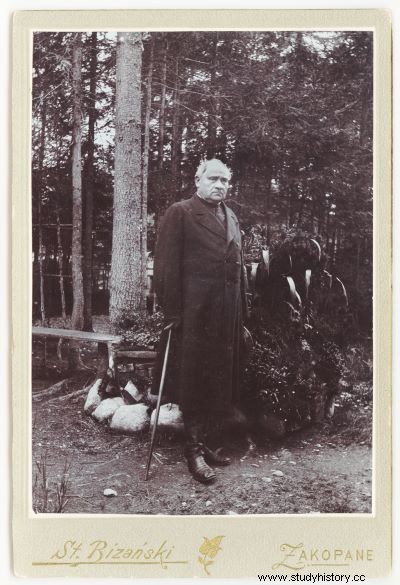Even in the mid-nineteenth century, Zakopane was a backward village, and in the area there was a legend about robbers and poachers. Zakopane lacked a well-developed accommodation and entertainment infrastructure, and to make matters worse, the tourist's journey from Krakow to Zakopane lasted half a day.
At that time, apart from single pranks, robbery was already a melody of the past, thanks to the outlawing of the injured who, using the privilege, punished local thugs. Most of Zakopane highwaymen were hanged for their crimes.
Today theft unknown in Zakopane; they do not even lock their houses at night [...], and you never hear of theft, unless foreign tramps collude to rob some wealthy gaze; and even such cases are very rare.
Janosik and other highwaymen
Wojciech Kossak mentioned that the most valued were not national heroes, but Janosik and his gang . Although the stories about the legendary robbers, their bravery, heroism and deeply rooted justice, consisting in robbing the rich and gilding the poor, were not true, they were mythologized and elevated, and in many Zakopane huts there were glass paintings with the image of Janosik and his relentless horde.

Janosik with his mistress.
The highlanders did not fantasize about death during the struggle for the freedom of the homeland, but about the robber's agony on the gallows. They believed that thanks to such a life they would remain in the memory and on the lips of future generations of Zakopane citizens for a long time.
Hey, when they catch me I'll be hanging
I will be rocking on the top of the herringbone!
Hey, turn me, master, towards the way,
Let me have a look at this rogue "go"
In the second half of the nineteenth century, the activities of robbers in the surrounding villages were no longer encountered, but ordinary thieves. However, and for such residents, they themselves administered justice through torture-based self-judgment to plead guilty, followed by a cruel punishment . In cases where the robber was to be brought before the court in Nowy Targ, he was previously subjected to painful repressions from the victims.

Panorama of the Tatra Mountains
The first parish in Zakopane
The first church in Zakopane was built in 1847 and is still located at Kościeliska Street. No wonder that before that time, the highlanders were not on their way to distant churches in Poronin or Chochołów, so the presence in God's sanctuaries was limited to one or two visits a year, and the knowledge of prayers and religious songs was far from ideal. In addition, there was a philosophical, and at the same time pragmatic, approach that was typical of highlanders, that if God is everywhere and they can talk to the Most High in the clearing, what is the meaning of weekly masses or listening to priests' sermons.
This well-established approach was faced in 1847 by the first parish priest of the st. Klemens (in later years, Our Lady of Częstochowa) in Zakopane. Father Józef Stolarczyk recalled this period in the parish book as follows:
[...] considering everything slowly, I found myself in a very sad situation. The parish priest - without the presbytery, without the church, without the inventory, without anything at all; in addition, a half-wild, cunning and greedy people who flocked around me to gain something, not from science, but from a penny, and I was without a gamer.

The first parish priest of Zakopane, Father Józef Stolarczyk, gained great sympathy and obedience among the highlanders.
The Apostle of Zakopane
Initially pastor Józef Stolarczyk was forced to make small loans and give gifts to encourage local people to attend mass and confession . Only a year after his arrival, the priest opened a village nursery, and the role of the teacher was given to the organist Jan Sławiński.
The idea for the development of education was appreciated by the inhabitants of Zakopane, but it was not only for this that the priest gained respect and obedience. His sermons were like a popular university for the highlanders. They provided secular knowledge about the surrounding world, personal hygiene, housekeeping, proper dress, behavior and education in the field of abstinence and unnecessary violence . He persuaded the residents to welcome holidaymakers and contacted tourists willing to come to Zakopane, finding places to sleep for them and mountain guides. Thanks to his entrepreneurship, the highlanders stopped starving and started earning money.
A charismatic parish priest who preached in dialect, helping the faithful in every aspect of life, undoubtedly had to be accepted and adored by the local community. Father Stolarczyk fulfilled the role of a host, taking good care of the sheep in his parish, bringing Zakopane highlanders closer to civilization.
Bibliography:
- A. Lisak, Sielankowanie pod Tatrami, Czarne Publishing House / Tatra Museum 2019.
- M. Steczkowska, Pictures from a Journey to the Tatras and Pieniny, Kraków 1858.
- W. Kossak, Memoirs, Krakow 1913.
- K. Przerwa-Tetmajer, Na skalny Podhalu, Warsaw 1997.
- After:W. Krygowski, An outline of the history of Polish mountain tourism, Warsaw 1973.
